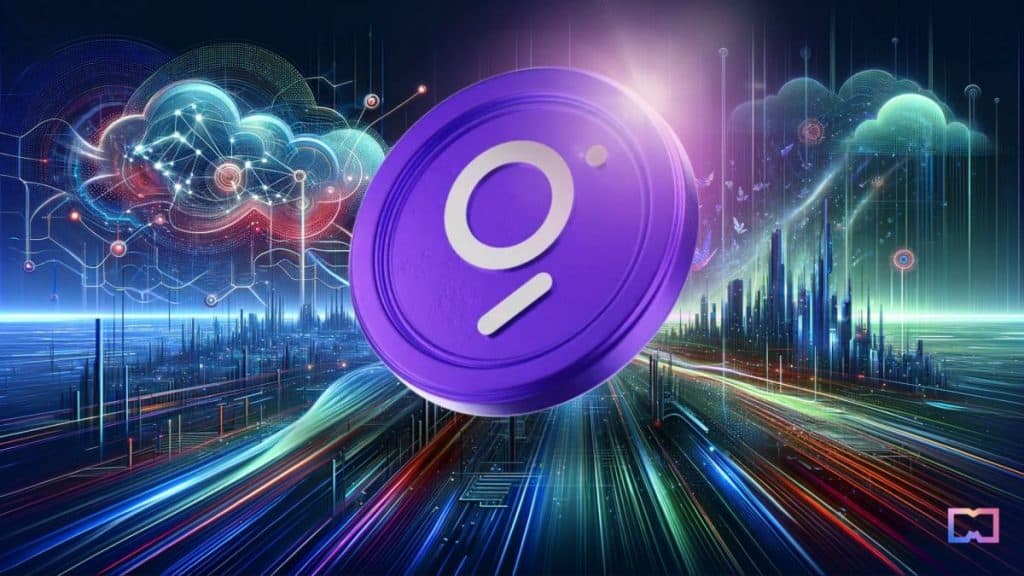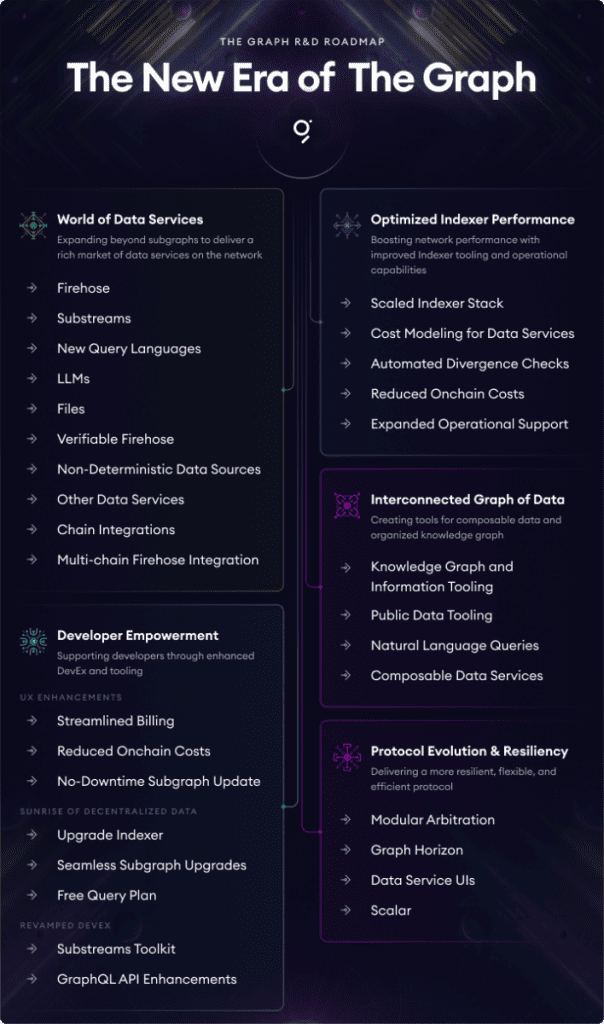The Graph Foundation Announces ‘New Era’ Update, Eases Web3 Data Access with AI Features

In Brief
The Graph Foundation announced the launched of “New Era”, an arsenal of new data features including LLMs, query languages and verifiable data.

Blockchain data indexing and query protocol The Graph today announced the launched of “New Era,” with user-centric features extending beyond subgraphs to an array of data services on its network.
The protocol said that the new updates will bring forth an arsenal of new data resources, including large language models (LLMs), innovative query languages, verifiable data and other features — to empower developers create the next generation of Web3 applications.
The Graph asserts that this marks the protocol’s significant stride toward establishing a unified, interconnected data graph that empowers the entire Web3 ecosystem, benefiting both users and developers alike.
The roadmap for this ‘New Era’ has been delineated in The Graph Foundation’s R&D plan, with five core objectives: expanding the realm of data services, enhancing developer empowerment through improved tooling, delivering a more resilient, flexible and efficient protocol, enhancing Indexer performance and crafting tools for composable data and organized knowledge graphs.
Notably, the roadmap offers a solution for accessing Ethereum‘s archive data when EIP4444 is implemented.
“Developers rely on subgraphs daily. Now it’s time to evolve the data interfaces for new types of users, which will make it easier for new types of applications and use cases that weren’t feasible before – such as new analytics dapps based of other query languages,” Eva Beylin, Director of The Graph Foundation told Metaverse Post. “The implication of this is expanding the pie of who can contribute and understand Web3. Our aim is that regardless of if you’re a dapp dev or data scientist, The Graph is the reliable foundation for accessing different sources of blockchain data.
Infusing AI with Blockchain Data to Aid Developers
The Graph said that the new era will also enable in enhancing tooling for web3 contributors, offering a more intuitive user experience (UX) and developer experience (DevEx). This will build upon protocol improvements designed to unlock new pathways for web3 data access, catering to users including data scientists.
Users can anticipate a suite of novel data services, headlined by the introduction of Firehose and Substreams, verifiable data, AI-driven query assistance using LLMs, and the provision of Files and Archive Data. Furthermore, new tooling will be introduced to ensure data consistency, facilitating rapid detection and debugging of Proof of Indexing (POI) divergences, which will, in turn, reduce on-chain Indexer costs —- to enhance protocol efficiency.
“Developers will benefit from devex and UX improvements, new data services supported natively in the network like firehose, and better tooling to continue improving Indexer performance. While new query languages, LLMs will unleash a new way for the community to interact with The Graph and enable devs to build their own data services,” The Graph’s Eva Beylin told Metaverse Post. “We’re also excited about verifiable firehose, which would enable a verifiable solution for retrieving historical Ethereum data after EIP4444.”
Concurrently, alongside the new era of the network, The Graph announced it is initiating the “Sunrise of Decentralized Data,” an initiative introducing upgraded Indexers, supporting the transition of all subgraphs to the network and facilitating support for all hosted service chains.
Sunrise will include a migration to the network free of charge and offer access to a new free query plan. Additionally, a network upgrade labeled “Graph Horizon” is set to simplify the protocol, making it more cost-effective and permissionless.
“Sunrise introduces an Upgrade Indexer, an Indexer to support subgraphs during their migration process, to ensure zero-downtime and support for all chains on the network. This will also provide the opportunity for devs to use a free query plan as they use the Subgraph Studio for their deployment or testing,” The Graph’s Eva Beylin told Metaverse Post.

What’s Next for The Graph Protocol?
Eva also explained that as new query languages are supported, data scientists can have their pick on how they want to analyze data. She believes that this also opens the door for new kinds of analytics applications to thrive, that are building on top of The Graph.
“If the subgraph isn’t already on the network, the Upgrade Indexer will ensure all subgraphs are moved from the hosted service to the network seamlessly with no downtime. This coupled with new billing features like credit card payments and subscriptions launched earlier this year, provide a user with all the tools to easily query data,” Eva Beylin added.
Eva asserts that support for natural language queries as part of the “Interconnected Graph of Data” will make new AI-based data use cases possible.
“We anticipate Indexers will begin to specialize in the chains and data services they’re interested in providing. Additionally, we’re working towards building a decentralized knowledge graph that combines all of these data sources in an accessible and composable way, which is only possible with a decentralized network,” she explained.
Eva said that The Graph Foundation envisions a world where accessing blockchain data is so incredibly easy and accessible that one doesn’t even realize there’s a decentralized network making it all possible.
“We’re focused on making a series of UX and DevEX improvements for that to be a reality and furthermore, ensuring that not only D-app developers but all user types can easily access the type of data they want,” The Graph’s Eva Beylin told Metaverse Post. “Having a proliferated marketplace of data and the ability for devs to make new data services, will unleash new ways for people to analyze and interact with blockchains.”
Disclaimer
In line with the Trust Project guidelines, please note that the information provided on this page is not intended to be and should not be interpreted as legal, tax, investment, financial, or any other form of advice. It is important to only invest what you can afford to lose and to seek independent financial advice if you have any doubts. For further information, we suggest referring to the terms and conditions as well as the help and support pages provided by the issuer or advertiser. MetaversePost is committed to accurate, unbiased reporting, but market conditions are subject to change without notice.
About The Author
Victor is a Managing Tech Editor/Writer at Metaverse Post and covers artificial intelligence, crypto, data science, metaverse and cybersecurity within the enterprise realm. He boasts half a decade of media and AI experience working at well-known media outlets such as VentureBeat, DatatechVibe and Analytics India Magazine. Being a Media Mentor at prestigious universities including the Oxford and USC and with a Master's degree in data science and analytics, Victor is deeply committed to staying abreast of emerging trends. He offers readers the latest and most insightful narratives from the Tech and Web3 landscape.
More articles

Victor is a Managing Tech Editor/Writer at Metaverse Post and covers artificial intelligence, crypto, data science, metaverse and cybersecurity within the enterprise realm. He boasts half a decade of media and AI experience working at well-known media outlets such as VentureBeat, DatatechVibe and Analytics India Magazine. Being a Media Mentor at prestigious universities including the Oxford and USC and with a Master's degree in data science and analytics, Victor is deeply committed to staying abreast of emerging trends. He offers readers the latest and most insightful narratives from the Tech and Web3 landscape.





















































